
This fall, Fairfax County will launch a guaranteed income pilot program, following in the footsteps of neighbors including Arlington County and Alexandria.
The upcoming Fairfax County Economic Mobility Pilot (FCEMP) will begin providing families with monthly payments totaling $2 million to “promote economic stability and social capital,” according to a press release.
The monthly payments of $750 will go to 180 eligible families chosen via application over the course of 15 months, with the funds being considered untaxable COVID-19 disaster relief that families have the freedom to choose how to spend.
The amount was determined by evaluating the cost of living in the county and the anticipated amount of time necessary to observe and assess the effects of guaranteed income on participants’ lives, a county spokesperson said.
Eligible families will also get access to optional financial coaching from United Way of the National Capital Area‘s Financial Empowerment Center, a partnership with Britepaths and the county, the county spokesperson continued.
“Like other basic income programs, the FCEMP promotes dignity and self-determination by enabling residents to take ownership of their own life and spending decisions,” the county website says.
Eligible applicants must be 18 years or older, have at least one child aged 16 or younger living in their household, and be employed with an income that falls between 150% and 250% of the 2023 Federal Poverty Level. They must also live in one of the following zip codes: 22306, 22309, 20190, 20191, 22041, 20170, 22003, 22150, 20120 or 20151.
The zip codes were chosen by overlaying current Opportunity Neighborhood boundaries and the zip codes they serve with the county’s Vulnerability Index, which analyzes a variety of factors such as race to determine vulnerable areas within the county, a county spokesperson said.
Through the pilot, the county says it hopes the regular payments will result in improved physical and mental health, improved educational outcomes for the children, increased economic stability, higher full-time employment rates, and increased housing and food security.
The pilot specifically aims to help certain households that “earn too much income to be eligible for assistance programs like TANF and SNAP but are struggling to make ends meet or are unable to take financial steps that would allow for economic mobility,” the county says.
As a result, households receiving public assistance benefits, such as Supplemental Security Income or Social Security Disability Income, will not be eligible. However, participants won’t lose their eligibility if they experience any changes in income or public assistance benefits during the pilot.
Supported by a partnership with Beam, a startup that helps administer cash assistance and social safety net programs, the application portal will go live on Sept. 23 and remain open until Oct. 3. Applications will be electronic only, and those selected will be notified via email or text.
The county has also partnered with George Mason University on a study of the pilot. Researchers will collect information from optional personal questions on the application “to understand the impact that unrestricted cash payments have on the economic and social well-being of working households,” the county says.
Participation in the study will not affect an applicant’s likelihood of receiving cash payments.
“Establishing a baseline understanding of families participating in the FCEMP is needed to inform a fully realized program over time,” the county says. “Thus, the FCEMP will measure the economic mobility gains and overall wellness of participants who choose to take part in the research component.”
The FCEMP is authorized by the Board of Supervisors and funded by the county’s general county and American Recovery Plan Act’s Coronavirus State and Local Fiscal Recovery Funds.
Photo via Sharon McCutcheon/Unsplash

Fairfax County’s government is the place to beat when it comes to utilizing digital technology, according to a recent survey of the top digital counties in the U.S.
Fairfax County was ranked no. 1 among counties with populations of 1 million or more people by the Center for Digital Government for its 2023 Digital Counties Survey, knocking off King County in Washington after the original home of Amazon nabbed the top spot two years in a row.
The top ranking marks the culmination of a steady rise for Fairfax County, which came in fifth place for its category in 2021 and second last year. King County, which includes Seattle, took second place this time around.
“We are constantly coming up with new ways to make things easier for our residents and employees through technology,” Fairfax County Board of Supervisors Jeff McKay said in a July 25 newsletter highlighting the achievement. “We would like to thank and congratulate our Department of Information Technology and agency partners for all of the excellent work they have done, and we look forward to seeing the great work continue!”
A division of the data and media company eRepublic, the Center for Digital Government describes itself as a national research and advisory institute focused on information technology policies and how they’re used by local and state governments.
The annual digital surveys, which include separate ones for states and cities, evaluate how different jurisdictions “are applying technologies to better serve their constituents,” the organization says.
After previously lauding Fairfax County for its cybersecurity efforts, the center says it managed to rise to the top this year thanks in part to an emphasis on data management and incorporation of data-based metrics into the Countywide Strategic Plan originally adopted in October 2021.
“Fairfax provided staff with training and policies about proper data collection and use, and conducted a data asset inventorying project so employees could more easily locate answers to internal questions,” the survey said. “Use of end-to-end encryption also preserves data privacy.”
Other accomplishments include a newly centralized “data lake” to support the Fairfax-Falls Church Community Services Board, which provides treatment and other resources for individuals with mental health, substance use and developmental disability needs.
The survey also singles out the county’s new Planning and Land Use System, which consolidated zoning, permitting and other land use applications into one central database. The system fully launched last October after starting to roll out in 2020, though it encountered some initial technical challenges.
“The platform gives constituents a single spot for handling activities like submitting and tracking applications related to zoning, building, permitting and other land development areas, as well as paying fees or submitting complaints,” the survey said.
In addition, the Center for Digital Government was impressed by the county’s expanding use of geographic information systems (GIS) data. Over the past couple of years, it has used mapping technology to track everything from heat and flooding to development in Tysons and Reston.
In general, the D.C. region performed well in this year’s Digital Counties Survey, securing first place in all five population-based categories.
The leaders — including Arlington for the 150,000-249,999 people category and Prince William for 250,000-499,999 people — were united by their prioritization of collaboration and inclusion, Government Technology said when announcing the results.
“Collaboration and inclusion were critical factors to their success,” GovTech said. “Their commitment to equity ensured that the benefits of technological advancements were accessible to all residents, ensuring widespread access to resources and creating a more inclusive digital landscape.”
Photo via Adi Goldstein/Unsplash
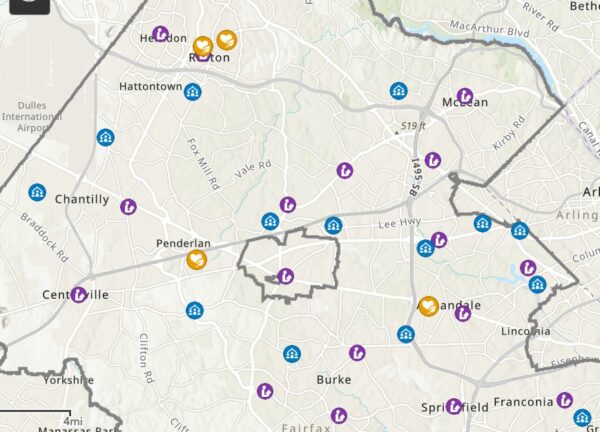
It’s another stifling day in Fairfax County with no immediate relief in sight.
As of 11 a.m., temperatures at Fort Belvoir had reached 90 degrees, but thanks to 65% humidity, it likely feels closer to 103 degrees outside, according to the National Weather Service.
An Excessive Heat Warning will remain in place until 8 p.m. today — only for another alert to take effect from noon to 8 p.m. tomorrow (Saturday). The NWS warns that “dangerously hot conditions” can be expected on both days, with the heat index potentially climbing up to 111 degrees.
To help community members, particularly those who are unhoused, Fairfax County has activated its Heat Plan for both today and tomorrow, establishing public facilities like libraries and recreation and community centers as designated cooling centers.
“When Fairfax County’s heat plan is activated, cooling centers around the county will be available during normal operating hours for individuals needing relief from the heat,” the county said. “These cooling centers will also have supplies available including bottled water, sunscreen, insect repellant, and body wipes.”
.@NWS_BaltWash has issued an Excessive Heat Warning for today, July 28, from 11 a.m. to 8 p.m. You can expect dangerously hot conditions with heat index values around 110 degrees.
In response, we've activated our heat plan, which includes cooling centers and supplies. pic.twitter.com/BtVB7qOC7i
— Fairfax County Government 🇺🇸 (@fairfaxcounty) July 28, 2023
The county is also distributing supplies through partners who work with unsheltered residents and at homeless shelters, drop-in centers and meal distribution sites.
In addition, overflow capacity is being allowed at the county’s three emergency shelters for adults: the Katherine Hanley Family Shelter in Fairfax (12970 Katherine Hanley Court), the Embry Rucker Community Shelter in Reston (11975 Bowman Towne Drive) and the Patrick Henry Family Shelter in Seven Corners (3080 Patrick Henry Drive).
Here’s more from the county on how to handle the high temperatures that have lingered since Thursday: Read More
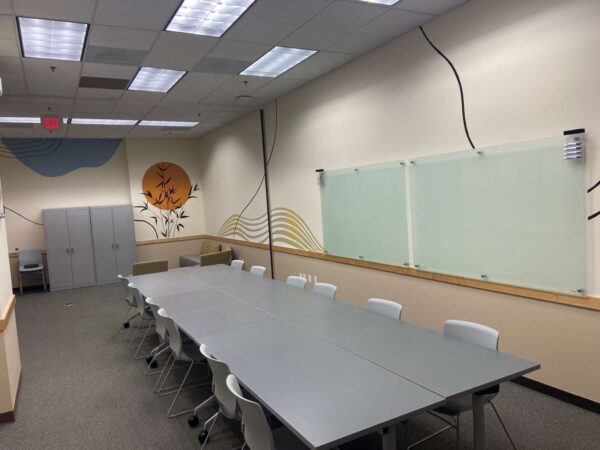
Soon, Tysons Corner Center visitors will be able to access the internet for free, check out a library book and learn how to prepare for college or a career all from the same room.
After closing at the beginning of the COVID-19 pandemic, Fairfax County’s Community Services Room at the mall will reopen on Saturday (July 29) with an expanded array of services.
The launch will include a ribbon-cutting ceremony at 10 a.m., followed by an open house so attendees can get acquainted with the available resources. The 2,280-square-foot room is located on the mall’s second level near Nordstrom.
“Our overall commitment is to create a stronger and interconnected community where everyone has access to vital resources, support, and opportunities,” Fairfax County Neighborhood & Community Services Communications Director Cristin Bratt said. “We hope this dedicated space for programming, community resources, library services and human services support will foster a sense of belonging in the Tysons area.”
According to NCS, Tysons Corner Center has provided the space to the county for “several years” as part of its development proffers or conditions. Prior to the pandemic, the room was used by Visit Fairfax, the county’s tourism agency.
Upon taking over management of the location, NCS says it decided to partner with other county agencies and local nonprofits to offer support services that residents may have difficulty accessing otherwise, particularly with Tysons still waiting on public facilities like a community center and library.
The community services room will include two computers that anyone can use to access the internet for the purpose of applying for jobs, social services benefits, a library card and other county resources.
NCS, which provides recreational, educational and developmental programs as well as basic needs assistance, will also use the space to offer restorative services and creative outlets for teens “engaged in high-risk behavior,” according to a press release.
To further assist youth and families in need, the department has partnered with the Arlington-based nonprofit Edu-Futuro, which focuses on immigrants and other underserved individuals.
The organization will provide mentorship, education, leadership development, case management, and college and workforce development services. Its staff at the community services room will be bilingual and trained to work with Latino, immigrant and English-learning youth.
The community services room will also host Fairfax County Public Library’s outreach team for school-age and teen services and the Fairfax County Department of Family Services:
Library Services for Teens — Fairfax County Public Library’s School-Age and Teen Services Outreach team will provide library outreach to teens who face barriers in accessing library services by empowering and engaging youth and demonstrating the value and relevance of the library. Planned Library services for teens include gaming, arts and crafts, STEM, book clubs, library resource workshops and more, as well as provide access to popular library materials via a curated pop-up collection available for checkout.
Domestic & Sexual Violence Services — The Department of Family Services’ Domestic and Sexual Violence Services’ onsite services will include education; training; help planning for safety; crisis intervention; and referrals to resources for shelter, housing, counseling, and legal assistance. Services are available to individuals, families and community members impacted by domestic and sexual violence, human trafficking and stalking.
Providence District Supervisor Dalia Palchik, who represents most of Tysons, says she hopes the community services room will serve as a “hub of opportunity” where different organizations can work together.
“Empowering communities is a catalyst for positive change,” Palchik said in a statement to FFXnow. “The new Community Services Room at Tysons provides a collaborative space for individuals to connect, learn, and grow together and serves as a beacon of opportunity, fostering unity and well-being among our residents.”
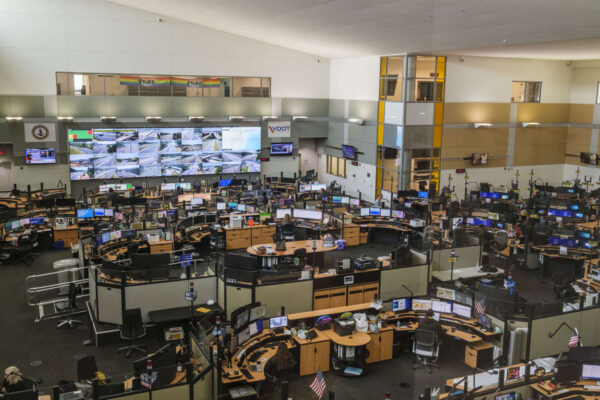
Handling 911 calls has never been a regular 9-to-5 job, but a national staffing shortage has increased the hours and pressure felt by call takers and dispatchers across the country.
Fairfax County’s Department of Public Safety Communications wasn’t spared from the workforce challenges that emerged during the COVID-19 pandemic, dropping from close to 180 staffers before 2020 to about 160 people right now.
The gap is sizable enough that workers are required to take about two overtime shifts every four months, but it’s not as drastic as the vacancy levels reported at other sites, even though the DPSC is the biggest 911 center in Virginia and one of the largest in the U.S., Computer Aided Dispatch (CAD) Officer Paul Ballerini says.
For instance, Richmond’s 911 agency, the state’s second largest center, reported earlier this year that it was 30 operators short, while D.C. had 39 call taker and dispatcher vacancies.
“Two additional mandatory shifts per person for a third of the year is not bad, especially hearing [about] other centers, reading online how some other similar-sized agencies are just doing tons of overtime,” Ballerini told FFXnow.
Initially, the pandemic didn’t have much of an impact on the 911 center. With people generally staying home and minimizing interactions with others, the volume of calls declined, according to Ballerini.
However, after a while, DPSC started seeing some of the same turnover that has hit other professions, from the police to trash collectors and restaurants.
“Like most other professions, people just started jumping jobs,” Ballerini said. “Not in a bad way, just people spent more time on themselves and learned about themselves and moved to other professions. So, we were hit the same as everybody else…so we started ramping up hiring and training.”
About 3,952 911 workers across 774 centers in the U.S. left the profession in 2022, often citing the stress of the job and options for better hours, pay and opportunities as their reasons for leaving, according to a study released earlier this year by the International Academies of Emergency Dispatch and National Association of State 911 Administrators.
While 27% saw no change in staffing levels over the past four years, nearly one-third of the study’s respondents reported vacancy rates of 30% or higher, including 13 that said at least 70% of their positions were unfilled.
Ballerini says Fairfax County’s current 911 staffing levels are slightly above its minimum standard after hitting maximum levels before the pandemic.
Every 12-hour shift must have at least four police dispatchers and four fire dispatchers on each of its four squads, which manage two district stations each. There are also ideally 20 call takers per day, though there can be as few as 13 people on the phones depending on the workload.
“Some people get through parts of training and realize it’s not for them and end up dropping out, but we work hard to try to stay consistent levels, not just for the public, but for morale inside the center,” Ballerini said. “I feel we’ve been pretty decent about doing that.” Read More
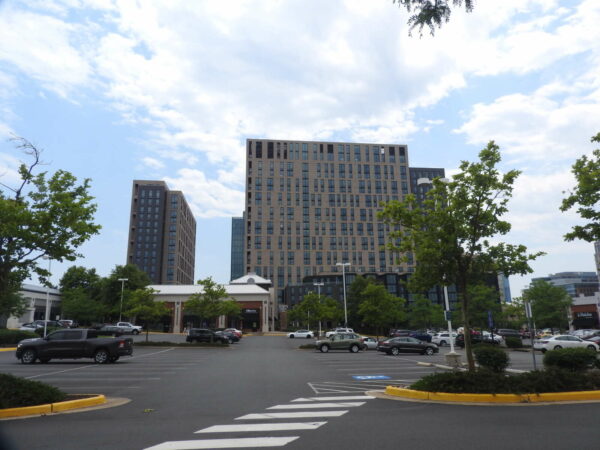
A Fairfax County proposal to overhaul parking regulations has attracted opposition from a local citizens group.
In a letter to the county, the Reston Citizens Association, a nonprofit citizen advocacy group founded in 1967, said the Parking Reimagined proposal does not fully consider the impact of the changes on Reston and the county overall.
“The RCA strongly urges that this proposal be withdrawn until at least such time as its conformity with the letter and the spirit of the One Fairfax Policy, the ADA, and other guiding principles can be achieved,” the letter states.
Specifically, two-page letter asserts that the changes will “significantly and adversely impact low-income, blue-collar workers, minorities, the elderly and disabled citizens.”
The effort kicked off in August 2021 when county staff began exploring ways to update an article of the zoning ordinance that regulates off-street parking and loading. Overall rates and regulations haven’t been comprehensively reviewed since 1988.
The initiative is intended to modernize those requirements and generally analyze parking and loading supply, demand factors, and loading trends.
On July 12, the county released a staff report on the issue ahead of Fairfax County Planning Commission hearings planned on July 26 and a Board of Supervisors hearing on Sept. 26.
“Significantly reducing unnecessary parking requirements in Metrorail station areas creates a return on the County’s investment in rail transit by aligning non-auto transportation options with transit access,” the staff report reads. “Reducing unnecessary parking supports placemaking as identified in the strategic plan and fosters a built environment where members of the community want to gather and where businesses can grow.”
If approved, the changes would go into effect on Jan 1.
The most significant change is a tiered framework that sets parking requirements based on factors like the availability and type of transit and the allowable density of development. County staff say it’s the “most critical new component” of Parking Reimagined.
Suburban centers have a proposed rate of 90% of the base parking requirement for nonresidential uses and multifamily units, while revitalization areas have a proposed rate of 80% of the base rate. Transit Station Areas and the Tysons Urban Center have a by-right rate of 70%, while transit-oriented development areas have a 60% rate. Some areas within those categories vary.
The proposal also allows the county to approve shared parking reductions and transit-based reductions of up to 30%.
In response, RCA asserts that the proposal doesn’t take into account a full range of transportation factors, including planning for future road, bus and rail routes and changes in employment and retail configurations.
RCA also calls the premise of the proposal — lower resident vehicle usage — “unrealistic” for the next 20 to 25 years, along with the minimum parking rates for multifamily units in revitalization areas, transit station areas, and transit oriented developments.
The organization also disputes the county’s rationale that reducing off-street parking will improve the environment, noting that the proposal doesn’t require developers to add green space and trees in exchange for off-street minimum parking.
The letter also flags the Reston Town Center area as not having enough access for cars, pedestrians and bicyclists.
“The RCA appreciates the significant work staff has put into this proposal and the outreach they conducted, and we stand ready to continue to work with staff to develop a proposal that will serve the citizens of Reston and Fairfax County in the years ahead,” the memo states.
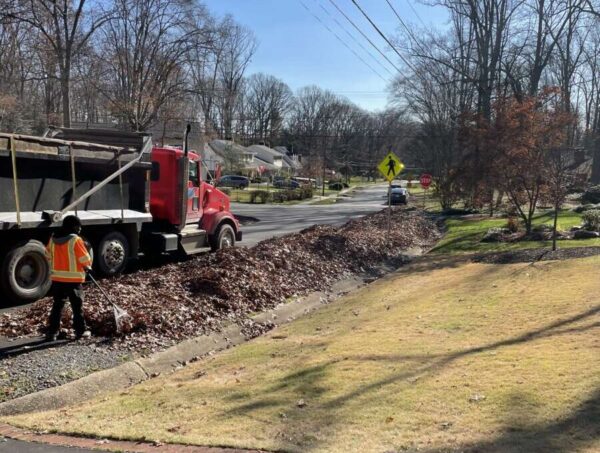
The coming winter’s leaf collection season might be Fairfax County’s last.
The Department of Public Works and Environmental Services has proposed terminating the leaf vacuum services it provides to thousands of residents after each fall, citing rising costs and “operational issues.”
A survey seeking public input on the recommendation has launched and will remain open until Aug. 18.
“During the 2022-2023 season, the program experienced numerous setbacks including collection delays, staffing shortages, a larger volume of leaves than normal, and inclement weather,” DPWES said in a news release. “After assessing the service, County staff propose to discontinue vacuum leaf service when the upcoming season concludes, along with the tax imposed for the service.”
Approximately 25,000 residents get leaf collection service through the county, according to DPWES, whose Solid Waste Management Program staff works with private contractors to vacuum up leaves from the curb three times a season, typically between November and January.
The collection areas are established through resident petitions and supported by a special tax based on property values. The eight areas that the county currently has are concentrated in the east, including parts of McLean, Idylwood, Bailey’s Crossroads, Lake Barcroft and Fort Hunt.
Last year, the county encountered delays in its leaf collections as it wrangled with staff shortages, equipment issues and an earlier-than-usual leaf fall.
DPWES says those issues could affect its ability to provide reliable service going forward, and customers have also raised concerns about lingering leaves disrupting public safety, including by:
- Blocking storm drains, creating flooding concerns
- Contributing to pedestrian and vehicle conflicts when pedestrians are forced to walk in streets
- Creating fire hazards from vehicles parked on leaves
- Presenting slip-and-fall hazards from people walking on slippery leaves
- Reducing on-street parking
Other considerations include increased costs and environmental issues. DPWES grinds up the collected leaves into mulch that’s distributed at various sites for free.
From the press release:
The County is facing increased costs to provide vacuum leaf collection. Due to the need for an additional contractor, overtime for County employees and temporary contractors support workers, it is estimated the 2023 season will incur an approximate $900,000 deficit and another predicted $400,000 deficit at the end of fiscal year 2024. The service also conflicts with the County’s adopted sustainability policies to reduce waste and greenhouse gas emissions.
The upcoming 2023-2024 collection season will take place as scheduled, since residents were already charged back in January, DPWES says.
In addition to filling out the survey, residents can weigh in on the proposal to end services by leaving a voicemail or texting “leaf collection” to 703-890-5898, Project Code: 2159.
A final decision will be made this fall by the Fairfax County Board of Supervisors.
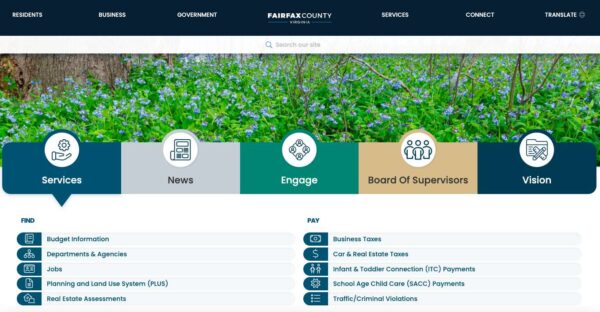
(Updated 11:00 a.m.) Visitors to Fairfax County’s website may have noticed that it recently got a digitized makeover.
Going live on Friday, July 7, the website update offers a range of upgraded services, including a bilingual virtual assistant with added Spanish language features and a “more readily available” language translation tool. Plans for the update were announced late last year.
Users can now also access a new email newsletter subscription management platform, giving “County agencies the ability to share more visually compelling content via email and text” and expand their “electronic outreach,” a county spokesperson told FFXnow.
The website’s homepage also got a facelift, focusing more heavily on the county’s Strategic Plan, One Fairfax and data analytics. The updated homepage further strives to foster more community involvement through an Engage Fairfax County portal.
Direct links to popular County services, such as real estate assessments, the PLUS land use and permit database, library access and park classes, continue to feature prominently on the homepage, the county says.
While information, links, site structure and department content remain the same, the county strove to update the visual presentation of the website’s information through “a new color palette and more modern elements,” the county said.
These costless changes were largely driven by feedback acquired from a 2022 public survey, which was used to create a draft design that the county says “received accolades from employees and the community.”
However, since the update launch, some website users have reported experiencing technical difficulties. For some, navigating the website prompted error messages that denied them further access to certain webpages.
“As with the launch of any new design of a website, the traffic to view and use the new site increases, which might have caused users to experience some challenges,” the county spokesperson told FFXnow. “We apologize to our customers that experienced any problems. We will continue to monitor and optimize performance.”
Updated at 1:15 p.m. — The mural unveiling has been postponed to Friday, June 30, due to potential inclement weather this afternoon, Fairfax County Neighborhood and Community Services says.
Earlier: Community members will be able to enjoy a colorful new mural in the parking lot of the Providence Community Center (3001 Vaden Drive) today, June 26.
Set to take place from 4-6 p.m., the mural unveiling event will include family-oriented activities and games, snacks and face painting. Providence District Supervisor Dalia Palchik will lead the ribbon-cutting ceremony, with Neighborhood and Community Services officials on hand for the event.
Without enough physical space to expand the center’s outdoor facilities and build a playground, NCS instead created the parking lot mural as an alternative means of engaging with the community and providing kids with increased outdoor programming, the county says.
“We thought this was a good idea and a good use of space to have a place where children can come out and play outside,” NCS Division Director Chris Scales said.
According to the county, the mural is the “first of its kind” at an NCS center.
The vision for the mural was brought to life by several artists of color, including muralist Kendra “Kay” Lee, Artbae and Artbae Foundation founder Cary Michael Robinson and NCS staffer LaShari Celistan.
Celistan, who is also a member of Artbae, initially “brokered” the partnership between the Maryland-based artist collective and NCS, which led Robinson to enlist Lee as the artistic lead of the project, Lee says.
Lee noted that the project’s primary goal was to create a “bright” and “interactive” space for children.
“Before, [kids] would just come out and play in the end of the parking lot with balls and stuff like that,” Lee said. “There was nothing really to do.”
To carry out this goal, Lee and NCS decided to pair “nature” and “popular games” as the mural’s dual theme. Lee spent three weeks painting both nature-related images — such as bees, sunflowers, snails, leaves and a caterpillar — and childhood favorites, like hopscotch, four-square and a racing track.
“[I wanted to make] sure that the kids could relate to the things that we were putting on the ground,” Lee said.
The team also tried to incorporate as much community feedback as possible, taking into consideration comments made by community members passing by as Lee worked to complete the mural. For instance, Lee says she and NCS decided to scale down certain interactive paintings after several parents remarked that their children were too small to jump between designated spaces.
“This is their neighborhood, and it’s important to them,” Lee said. “…So we definitely wanted to make sure that they…felt included in the end product.”
As the pioneer behind an art-based community engagement project, Lee expressed that she hopes the county continues these types of projects and “look[s] forward to doing more.”
“I’m just excited for the reveal and excited to actually get the feedback from the community because at the end of the day, I just hope that my idea and [Celistan’s] idea and the things that we put together really meets the needs of that area,” Lee said.
Attendees of the mural unveiling will also have the opportunity to vote on a new name for the community center, which is set to be renamed in honor of former Providence District Supervisor Jim Scott. Voting is open through Monday, June 26, and votes can also be cast online.
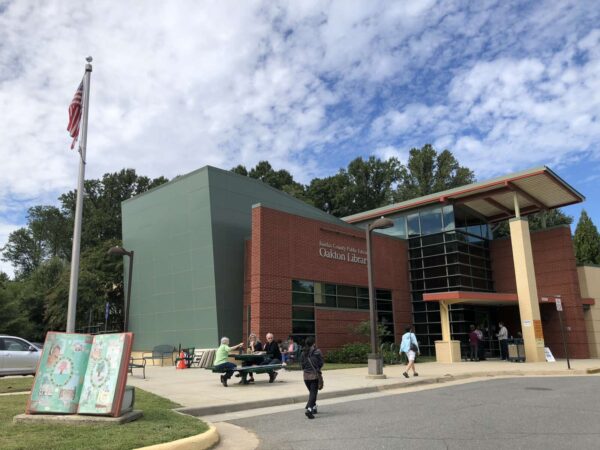
As homelessness increases in Fairfax County, affected residents can use revamped county resources to cope with extreme summer heat.
The county will activate its extreme heat response when the National Weather Service issues a heat advisory, excessive heat watch or excessive heat warning.
As part of the response, 47 county facilities are now designated as cooling centers and will provide supplies, such as water, sunscreen, insect repellant, body wipes, and bus passes, according to a presentation to the Board of Supervisors’ health and human services committee last week.
“Like in previous years, all county facilities that are open to the public can be used by residents to come in for cooling,” Jill Clark, health and human services policy and planning manager with Fairfax County Neighborhood and Community Services, said in the presentation.
The cooling center facilities include all libraries and community centers. In those locations, staff will be prepared to welcome residents in need, and there will be supplies and seating in designated spaces.
Supplies will also be available at shelters and drop-in centers and from outreach workers. Most of the supplies are single-use and/or lightweight and portable. The decision to supply single-use items, among other parts of the plan, came from feedback from a September 2022 survey of 81 unsheltered residents.
“In the responses, you could hear the challenges they experienced both in terms of discomfort and real negative health effects from the extreme heat, including nausea, shortness of breath, exhaustion, asthma attacks, inability to eat as well as sunburns and rashes,” said Tom Barnett, deputy director of housing and community development in the Office to Prevent and End Homelessness.
The county will also aim to better notify unsheltered residents about heat advisories by using a new dedicated channel of Fairfax Alerts.
“We learned through the unsheltered residents survey that most respondents actually have a phone with internet access, and actually prefer getting information about resources and heat alerts via text messages and emails,” Barnett said.
To help residents get to cooling centers, drop-in centers or weather-related overflow sites, the county will offer free Fairfax Connector bus passes in the form of 3,000 postcards that cover two rides each. In addition, the county will provide pre-loaded Transportation Options, Programs & Services (TOPS) cards to assist unsheltered residents who cannot access Fairfax Connector buses.
These changes came out of recommendations from a workgroup that formed in August 2022 in response to concerns raised by the Fairfax County NAACP. The board received the workgroup’s recommendations in a March memorandum.
“The work group and its four committees included a robust membership across many different county departments as well as key partners and representatives from the homeless service providers, the faith community and advocates,” Barnett said.

